Setting up and syncing config on two laptops¶
I’ve created a script that should [1] set up a fresh Manjaro with all the software and configuration that I want in a workstation. It can also update the setup on being rerun. Now I have two laptops that behave and look the same [2], and it’s easy for me to maintain that state. Oh I wanted that for a long time :)
Using the script¶
I can just clone the repo and run make setup_workstation.
If I want to update the setup on one laptop after tweaking it on the other one (and writing it down in this repo, of
course), I just run the same make command.
Well, actually I have an upgrade shell function for that.
I’m also rerunning it from time to time to make sure everything (including Tmux and NeoVim plugins) is up to date.
About this post¶
From here on this post might get a bit (a lot?) ranty. Also, it includes something like a journal from working on the script. I did very little editing in that part. It’ll be a bit like a stream of consciousness and will illustrate my thinking during work. It’ll have random stuff, might be hard to comprehend and it’ll be hard to get through. But it might show you some tools and tricks I employ, so maybe it’ll benefit somebody :) Read at your own risk :)
More context¶
I know many people have written tools for maintaining their dotfiles, configs, etc. Well, I’m adding one that fits with my development style ¯\_(ツ)_/¯ You might find it also fits with you, especially if you’re comfortable with Python.
Some small bits still require manual intervention, but at least they’re documented in the text that gets printed at the end of the script run. So I should never again forget how I set something up, to then waste time on Googling some years later :)
It’ll also allow me to adapt to other Linux distros way faster. In the future, I’ll modify the script to set up my Raspberry PI (now it just handles Desktop Manjaro), and maybe also to configure servers on which I want to have coding tools.
There are still a few mildly annoying differences:
something being off with fonts on the heavy laptop (maybe some font package conflict?)
light laptop not showing my wallpaper on login screen, even though LightDM config is the same
probably some others
But I can live with them. And maybe I’ll solve them accidentally, while doing other things in the future :) And I do have a solid base, which won’t be so time-expensive to maintain, that I won’t do it, which was the case before, when I had an Ansible script that had the same purpose.
You might wonder why I didn’t go with Ansible, and wrote a custom script instead. Here’s some reasons:
it would require me to write some modules (and scripts for change detection) to get it 100% accurate with showing what’s changed; interplay between that code and playbooks would be more awkward than just writing all of it down in Python (in my estimate)
way slower than my script (it just takes so long to run any Ansible step locally)
it would require me to look in docs a lot, and think about what’s the “Ansible way” of doing things. For me it’s just way easier to think about what’s needed, and then coding that in Python.
I think it’s time for me to forget about Ansible. I used to use it in some of my previous jobs, I wrote some scripts for myself, but I don’t think I need it in my toolbox anymore. Unless I’m gonna work with a fleet of non-virtual servers, which hasn’t happened to this date. If I were to spawn infrastructure I’d use Terraform (you can use Ansible as instance setup scripts, but that just needlessly more complicated than using shell scripts). If I was deploying applications I’d use containers and Helm or Docker Swarm (that would run on infrastructure set up with Terraform).
Up to this point I haven’t mentioned what computers I have:
Alienware 15 R3; bought in 2017 (can still perform well); the heavy / the main one; hostname “bh”; had Kubuntu 18.04 on it till recently, now’s on Manjaro
Huawei Matebook D 14; bought in 2019; the light one / the secondary one; hostname “bl”; contains my first Manjaro install; I bought it because of the very good price to value ratio in Poland; has some quality issues (like overheating and crashing when under load and charging)
Some loose thoughts¶
Not all config files are Git-friendly.
Programs use config files and directories for caching data, which they shouldn’t do.
If you’d try to put those files in Git you’d have constant changes.
It’s getting better with some software, though.
Ranger has option to not store the “most recent” bookmark on disc (it was changing while you were using ranger),
KeyPassXC sensibly separated stuff like current window sizes from other config params in a config that goes under
~/.cache.
NixOS seems to have a solution for maintaining all of your system’s configuration in text files, and I applaud it. But I’m just not ready to drop all the niceties (a lot of packages, on-line resources) of a well-maintained and popular distro like Manjaro. Also, I can adapt and use my script on multiple devices with multiple OSes. From what I see NixOS isn’t yet supported on Raspberry Pi 4, and I can’t just spawn a NixOS VM on Digital Ocean. Of course it would be great if other Linux distributions went the way of NixOS with package installation.
Some distilled articles may come from this post in the future, but not just yet. Other priorities.
Log / journal¶
This whole Log thing would probably work better (also for me) in a video format… Gotta give that a try some day. Maybe next log will be in video format. I hope I won’t spend too long editing :)
Gotta do some gesture or something when I’m putting in secrets or showing keepass, so I’ll know to edit out all of those instances… Or maybe I should see all the times that I press my keepass shortcut? (Super + 3). We’ll see :) Probably the simple thing with a (hand)signal on the video will be simple enough. Hope I won’t miss anything that way and it won’t be too tiring. Anyway, that’s something for the future.
2021-09-07
What I’ve installed:
mpv
everything in the bootstrap script
ranger - atool: for previews of archives - file: for determining file types [installed] - highlight: for syntax highlighting of code - libcaca: for ASCII-art image previews [installed] - mediainfo: for viewing information about media files - poppler: for pdf previews [installed] - python-chardet: in case of encoding detection problems [installed] - ueberzug (even though ranger mentions “python-ueberzug”, that doesn’t work, because it’s under different python): w3mimgdisplay alternative
the_silver_searcher
dropbox
dropbox-cli
base-devel
keepassxc
2021-09-08
Carrying on with ranger config updates - created default configs,
comparing them to mine with meld.
that should be done every now and then - post about it?
Nope, can’t finish ranger, gotta set up my aliases and functions so I can use the computer more normally.
$ meld .zshrc .zshrc.the_link
.zshrc is what Manjaro Architect set up for me when I said I wanted ZSH as my shell.
It gives me Powerline with nice command statuses and execution times
(something I was getting with plugins from Oh My ZSH).
I want to merge that into my config later, but I need stuff in the shell to work right now, to help me with my actual work (automation of my work setup creation - including “stuff in the shell”).
How much more time I’m spending on this (writing down the “log” / diary) compared to how much time I would spend doing just the Ansible and immediate manual setups (that will be added to Ansible by the time I’m done)?
But maybe, if I wanna blog, then keeping this “log” will be a quicker way of pushing out my “content” (I have Luke Smith saying that in my head now). The slower way would be what I usually do, which is edit the posts to make them as succinct and information-packed as possible. Sometimes, at least :) I would like to rant a bit more, from time to time, though… People sometimes enjoy these (rants) in real life.
I have to keep the log in tidy English, though. Like I would use when I was writing to a work colleague. That requires bits of editing, but, I try to just do them per paragraph. Once the paragraph is done, it’s done (at least that’s the approach I’m testing in practice right now :) ).
What I normally use in my personal notes is this weird mix of Polish and English. You know, some thoughts flow quicker in English, some in Polish. Depends on where I have the most practiced vocabulary :)
Keeping a log (with exact bits of scripts) should be a good way to backtrack during a debug session. Can’t do that if you’re in an emergency that requires urgency, though. Guess you can look at your shell history if you need to backtrack in those situations.
Anyway, back to the meld.
I’m getting everything from my config that will be useful, but will not break.
So probably that’ll be everything like basic settings, and scripts and aliases from my
configs_and_scripts repo.
Still, that’ll be a lot of help :)
That’s how the file looks like now:
# Use powerline
USE_POWERLINE="true"
# Source manjaro-zsh-configuration
if [[ -e /usr/share/zsh/manjaro-zsh-config ]]; then
source /usr/share/zsh/manjaro-zsh-config
fi
# Use manjaro zsh prompt
if [[ -e /usr/share/zsh/manjaro-zsh-prompt ]]; then
source /usr/share/zsh/manjaro-zsh-prompt
fi
# Butla config
# If you come from bash you might have to change your $PATH.
export PATH=$HOME/bin:$HOME/.local/bin:/snap/bin:$HOME/.local/lib/node_modules/bin:$HOME/.cargo/bin:$HOME/go/bin:$PATH
export EDITOR='vim'
# enable vim mode
bindkey -v
# normal delete and backspace with VIM mode
bindkey "^D" delete-char-or-list
bindkey "^?" backward-delete-char
source ~/.config/zsh/aliases.zsh
source ~/.config/zsh/functions.zsh
# fd configuration, mainly so that FZF works more to my liking
export FZF_DEFAULT_COMMAND='fd --type f --hidden --follow --exclude .git'
# if less than one screen worth of output, just print it on stdout
# Without this Git on ZSH was trying to put everything through a pager.
export PAGER="less -F -X"
Huh, I noticed that my old config has this note in it:
# TODO remove after alacritty fix? https://github.com/jwilm/alacritty/issues/2515
# Needed to make apps start in the foreground
unset DESKTOP_STARTUP_ID
Shift+clicked the link above with Alacritty :)
Looks like it got fixed, merged into master on Jun 16, 2019, so I bet I have that installed :) And basically, they do that for me, so I can remove the code bit. Also, I won’t be using KDE anymore.
Removed that bit of config while in meld. configs_and_scripts repo notices the update because of the link.
Saved both the files (both got updated) and closed meld.
Installed xsel so I can copy file names from my ranger in my “development view”, while writing this post.
Need the copy, so I can paste image file paths into workstation_setup_with_ansible.rst with nvim.
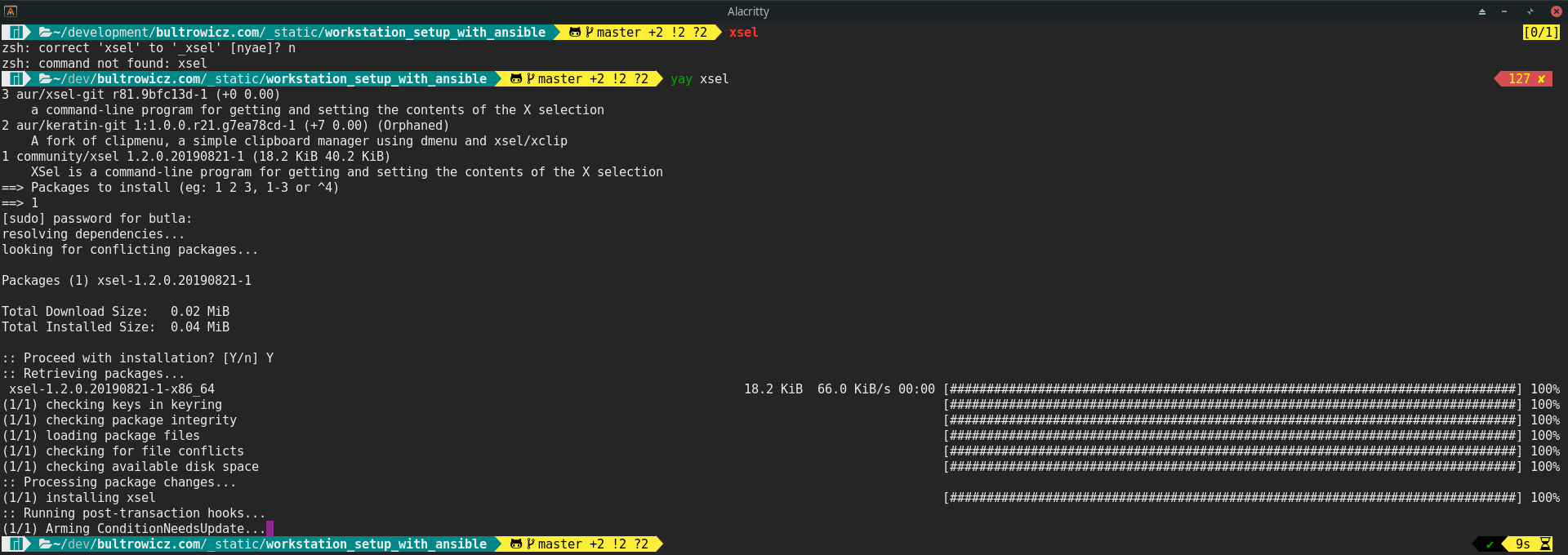
Now, I can paste the previous images I wanted to paste :)
So the one confirming that configs_and_scripts got updated when saving with meld:
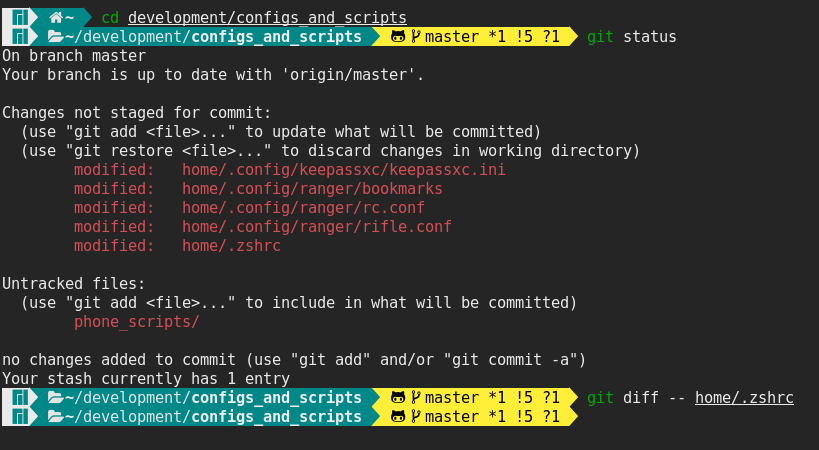
And the one showing the diff itself:

My work setup is slowly coming back to life :) Better than ever. Such a great feeling.
I had to find (remind myself how to) input images into .rst files :) With ag (“the silver searcher”), BTW :)
Ok, and now I wanna keep looking at my post, see how the images I’ve added look.
So I’m gonna run some make commands in additional tmux panes:
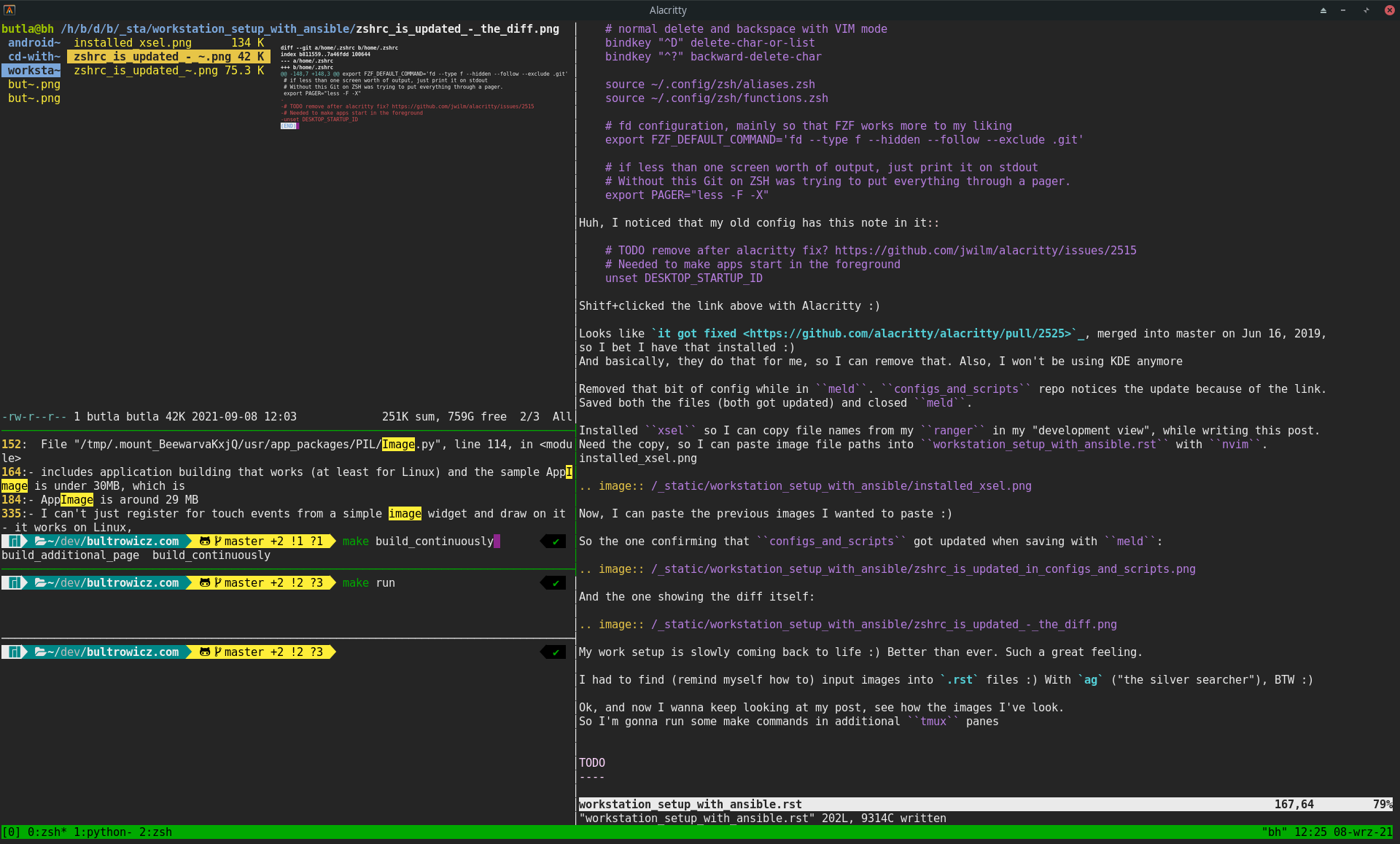
Oh shit, I need entr… Never-ending story xD I need that Ansible to never go through this again :)
Well, maybe for a few years, at least. And I’ll have a better base for the new automation :)
Or maybe, I’ll really keep updating it throughout the years.
Or I’ll just never leave Manjaro :D Just keep expanding the script to more OSes
(wanna play around with Qubes on an additional partition).
$ sudo pacman -S entr nice, it’s in the community repos now.
Oh no! I need virtualenvs for the rebuilding to work xD Ok, I gotta order food :) (time: 12:31+02:00)
Food will be ready for 14:00, around the time Monika (ze wife) comes back from work. New restaurant opened at 7-minute-walk distance. Please God, let it be a good one :)
Back to no virtualenvs for rebuilding.
Had to run these to get the virtualenv running and activating without going through the virtualenvwrapper install just
yet (Ansible will do it later):
mkdir ~/.virtualenvs
python -m venv ~/.virtualenvs/bultrowicz.com
. ~/.virtualenvs/bultrowicz.com/bin/activate
Oh! Vim indicator is working in this Powerline setup! This is so nice :) I gotta have it.
Now that I’m in an activated virtual env (and I have fd and entr), my make commands should run!
…Yeah, I need to install the python dependencies first :):
$ which pip
/home/butla/.virtualenvs/bultrowicz.com/bin/pip
$ pip install -r requirements.txt
Collecting ablog==0.10.17
Downloading ablog-0.10.17-py3-none-any.whl (55 kB)
|████████████████████████████████| 55 kB 1.3 MB/s
Collecting alabaster==0.7.12
Downloading alabaster-0.7.12-py2.py3-none-any.whl (14 kB)
Collecting Babel==2.9.0
Downloading Babel-2.9.0-py2.py3-none-any.whl (8.8 MB)
I wonder how powerline fonts will get rendered after pasting into an rst code snippet…
$ make build_continuously is working! I’m fixing the issues cropping up in this file there.
Once my NeoVim setup is done, I’ll get these in the editor, directly.
13:01, time to get up from the computer, stretch (just a few seconds), and do some house chores :D Hungry now, just had some apple today. Bao incoming in about 1h15m :)
Unpacking new “gear”: window washer (for the dirty, Silesian windows) and a USB-C to micro-jack adapter, for my sad Samsung phone (why did they have to go the Apple way?).
Need some music:
yay spotify
# picked: `3 aur/spotify 1:1.1.67.586-1 (+2219 31.11)`
And it’s running. Logged in with data from keepassxc.
I need my git aliases, so installing fzf: $ sudo pacman -S fzf.
Pushed configs_and_scripts updates with ranger stuff to origin.
Checking if ranger is fine on the other laptop…
It wasn’t. Ueberzug was crashing because of failing to load PIL.
Turns out I had an outdated AUR package - python-pillow-simd - providing Pillow, instead of the usual python-pillow.
Installed the latter, it replaced the former, everything is dandy.
2021-09-09
$ yay ansible -> pick 1 community/ansible 4.4.0-1.
Gotta squash the commits in my machine_configs repo before I make it public.
There might me some encrypted keys there that I might still be using.
It’s encrypted so it’s not like anybody should be able to retrieve them.
But maybe it’s better if I don’t leave these encrypted blobs on public repos,
for indexing and use (and maybe exploitation) by some future cypher-craking efforts ¯\_(ツ)_/¯
Juuuuuust in case :)
Huh, running my shrug alias to paste in here - the system detected that I don’t have xclip and offered
to install it. Nice of it to do that :) Oh, but pamac or something can’t accept my “acceptation” :)
No stdin attached?:
$ shrug
¯\_(ツ)_/¯ copied to clipboard...
The application xclip is not installed. It may be found in the following packages:
extra/xclip 0.13-3 /usr/bin/xclip
Do you want to Install package xclip? (y/N) y
Executing command: pamac install xclip
Preparing...
Synchronizing package databases...
Resolving dependencies...
Checking inter-conflicts...
To upgrade (1):
thunderbird 91.1.0-0.1 (78.14.0-0.1) extra 66.5 MB
To install (1):
xclip 0.13-3 extra 15.3 kB
Total download size: 66.5 MB
Total installed size: 21.9 MB
Apply transaction ? [y/N]
Transaction cancelled.
$ yay xclip -> “1”, and then:
shrug
¯\_(ツ)_/¯ copied to clipboard...
You’ll see it used above :) I do backtrack a small bit in this “log” :)
Ok, so gotta squash the commits, put the repo up on Github. And then, I’ll replace most of the old various machine setup scripts with a single new one for the machine I’m working on right now (my main workhorse). Different “machines” are:
my main machine
my old Raspberry PI
some arbitrary in-between ones that might, and might have not, have been used on some cloud instances
If I’ll have automation for different machines, it’ll be extracted (and refactored) from the monolithic script for the setup of my workstation.
squashing commits / pushing to a new repository
$ git remote -v
origin git@bitbucket.org:butla/machine_configs.git (fetch)
origin git@bitbucket.org:butla/machine_configs.git (push)
That’s my private repo (now you know it exists, OMG! :) ).
Soft-reset to the first commit of that repo (hell, I’m gonna even leave the message, cause it’ll be a nice trace :) ):
git reset bf8963456ef42a24a0356cfe95ccb9771d724cbe
Stage all the files for the commit:
git add .
Add everything to the original commit:
git commit --amend
Now, there’s just a single commit:
$ git log
commit 9599e326ca16836b8b1b632505fd6f309c033e70 (HEAD -> master)
Author: Michal Bultrowicz <michalbultrowicz@gmail.com>
Date: 2017-07-02 13:32:12 +0200
Initial commit, moved from Bitbucket with squashing of history
Before Bitbucket, the stuff was at https://github.com/butla/utils
Now, I have to create an empty repo on Github. I’d like to move everything to Gitlab one day and make Github repos into mirrors, I don’t like Microsoft handling most of the world’s open source…
Switch the origin to the new repo:
$ git remote set-url origin git@github.com:butla/machine_setups.git
$ git remote -v
origin git@github.com:butla/machine_setups.git (fetch)
origin git@github.com:butla/machine_setups.git (push)
And push it out to GitHub with $ git push.
I also added a note on the Bitbucket repo (in the repo description) pointing to the new repo. I’m not removing the repo from Bitbucket, in case I ever need to consult the old git log.
Man… there’s a lot of old TODOs I left for myself in that repo.
It’s a bit overwhelming. They’ll need to get purged.
I’m either solving the problem or letting it go.
All of the Kubuntu-specific TODOs can go, fortunately.
The ones about config files as well (because of configs_and_scripts).
And a lot of complexity with getting the software (PPAs, downloading and compiling myself),
goes out of the window because of how rich and up-to date the Manjaro (and Arch) repos are.
Also, there’s AUR.
The repo right now is basically bitrotten old Ansible for systems I’m not using anymore and a bunch of TODOs and notes. Well, I gotta change that into Ansible that’ll actually run on both Manjaro laptops.
We’ll see if it won’t be too much of a hassle to keep the laptop’s software in-sync with Ansible… Hopefully it won’t, and I’ll have a forever-up-to-date resource that can recreate my workstation with one command. And it’ll be the perfect documentation of my setup.
Anyway, gotta create the new blank-slate playbook and start putting everything that’s useful from around the repo into it. Maybe I’ll consult the updated Ansible best-practices first… Dunno if there’s a page like that anymore. Ansible’s documentation sure got more confusing. Do I look at “community”, “core”, or which docs? There’s overlap between them as well… Well, I guess “community” is the way to go.
They sure added a lot of stuff in. And made commands more clunky with the namespaces
(e.g. command -> ansible.builtin.command).
Should I even bother with Ansible? It looks like it’s gotten so big. And I probably wouldn’t use it in production now (I’d like immutable VMs with Terraform, Docker, Packer). But maybe there will still be some utility to it. It looks like you create playbooks and roles pretty much the same way as you did it two years ago (last time I wrote any Ansible). So let’s see if can create this script in a relatively painless manner.
If not, my setups will just be maintained with bash scripts :) I do think Ansible is nice with the idempotence (and rerunning not breaking stuff), though. But maybe the overhead is too big… Dunno.
Ok, starting with a single role - main_machine.
First, just install all the packages I need (I’ll gather them from the repo and notes).
Gotta look into the docs to see the Ansible module for that on Manjaro (there was a universal one).
Ok, Ansible is too much to handle for me ATM. Writing stuff in it requires me to just go the docs too often. I don’t think I need it in my toolbox anymore. So long, friend… Let’s see how will the environment setup look as a Bash script. I won’t be able to just rerun it on both laptops to keep everything in sync, but it probably won’t be a big problem to run the updates selectively.
Woah, Manjaro automatically found my printer/scanner in the local network, and I can scan/print without setting anything up. So civilized :) I’ve heard that even Debian got some driverless scanning/printing support nowadays. Linux is making progress, I guess :)
OK, I’ve deleted the old Ansible scripts, pulled their logic into the shell script (almost). This is going to be so much simpler, although I’ll need to implement small functions for idempotent setups of certain things, like pulling git repos. I don’t have to go too overboard with it, though. It’ll be way easier to maintain than Ansible, I think.
2021-09-10
Working on the script.
All of the python tools that I used to install with pip install –user I now have taken either from Manjaro repos
(with pacman) or from AUR (with yay).
We’ll see if this works well for me. If not, I’ll try to use pipx for maintaining them.
Too bad that yay doesn’t have an option to skip what it’s already installed.
I’m working on a workaround for that, though.
My initial idea isn’t working for some reason, so I’ll leave it for when I have the full setup done.
It looks like I’m only missing NeoVim and ZSH configs, and plugins for NeoVim, ZSH and ranger.
I love how much software is available as packages on Manjaro (and Arch, most probably) and how recent they are. Finally, a distro that doesn’t lag behind the software I use. Ubuntu did that. And something would always break for me when upgrading the whole OS, so I just stayed with the LTSes.
2021-09-14
Rewritten the setup script to Python from Bash because I’ve come across something that was problematic in Bash (picking AUR packages that weren’t installed already). That usually happens when you get slightly more complicated logic in scripts. If it starts looking ugly and/or confusing in Bash, it might be time to switch your script.
2021-09-15
I was praising the great number of software packages available and how recent they are on Manjaro.
That’s not always the case.
oh-my-zsh, for example, has last been updated in January (I know that from pacman -Si oh-my-zsh).
I know that the manual install I have under ~/.oh-my-zsh has updated itself many times since then.
So I guess I’ll stick with it. Shame, I’d like to manage as much software as possible with just the package manager.
I’m merging my .zshrc with the one that was created for me by Manjaro Architect, when I chose ZSH.
I got some ZSH options out of it, and I will get that “powerlevel10k” theme, because it’s just awesome - functional
and looking good. I’m discarding everything else.
Weird how I have the powerline fonts and icons on the machine setup with Manjaro Architect without having the packages
(powerline-fonts, awesome-terminal-fonts)that provide them on the second laptop.
Looks like Architect has set me up with something non-standard?
It definitely adds manjaro-zsh-config package, but I don’t see any fonts in it.
I should probably compare the installed packages to solve this.
I let powerlevel’s config script (p10k configure) modify my .zshrc.
I still needed to add sourcing of powerlevel10k.zsh-theme above sourcing of p10k.zsh.
2021-09-16
My Python setup script is taking care of the idempotency on it’s own. Writing the necessary code is more natural and faster for me than dealing with Ansible. Does it do some things less reliably than Ansible? (Like making sure that the repos I’m pulling are up to date?) Yup. But it’s enough for my use. And I can tweak it however I want without hurdles, browsing the docs, or writing my own Ansible modules (I am writing my own “module” from the start).
I’m not putting in any tests (and I’m a testing fanatic), but it won’t be a problem to diagnose and fix the code when I’m using it. Also, I’m the only user. I am preparing myself for running this on a fresh Manjaro install, though. I’m running all the code that I’m adding, and most of the changes I make are done with the code. Sometimes I install/setup stuff manually, then tear it down and let the script do it.
Alacritty (or another terminal emulator) defines what colors like “blue”, “light blue”, etc. mean, most programs say they want “blue”, “light blue”, etc. That’s how you can tweak terminal colors in most programs (ranger, ls, ZSH). You can also choose different colors in those programs.
I finally enabled KeepassXC to be a Secrets Service. That will prevent Brave (or Chromium) and pip from asking me to put in my password for Gnome keyring every time I use them. Dunno how to make Brave pull the passwords from KeePass, though, but that’s not important now.
Magically, the KeePass on stopped putting temporary local configuration options (window size/position, last opened DB)
into ~/.config/keepassxc/keepassxc.ini and started putting them into ~/.cache/keepassxc/keepassxc.ini.
Finally, I won’t get any random changes in configs_and_scripts files.
More info on the separation of configs.
Different autostart programs for two of my laptops made me introduce host-specific configurations
into configs_and_scripts. It was quite simple to do
with the way my code was set up.
2021-09-17
Now, I need to change some system settings (like desktop theme) and store that in configs_and_scripts.
I want to get to the config files without having to dig through documentations of programs.
I can check what files the programs are modifying myself with strace.
Getting a process ID related to a window you click: xprop _NET_WM_PID.
Starting a trace of all the files being opened and closed by a process with a given PID:
sudo strace -e open,close -p <PID>.
Putting it together:
sudo strace -e open,close -p $(xprop _NET_WM_PID | cut -d ' ' -f 3)
Huh… some config files are already opened by the time I attach, so I don’t see their paths
(they only appear in “open” calls), but I can use lsof to see the files that the process has opened already.
Of course my plans are foiled again by software that just can’t maintain its configuration in git-friendly text files…
Manjaro theme is being saved into ~/.config/dconf/user, which isn’t a text file…
I guess I need to use dconf to be setting that correctly in an automated fashion.
So it’ll go into machine_setups as a command I run, and not in configs_and_scripts as just, well, a config file.
Now, how to use dconf to set this… I didn’t want to search for stuff, but they forced me again…
I could just leave setting the dekstop theme as a manual step in machine_setups (at least it’ll be documented),
but now I’m interested in seeing how much XFCE can be configured between different machines without GUIs.
With KDE it seemed to be impossible.
I’ve searched for the theme name in ~/.config, turns out it’s also saved in
~/.config/xfce4/xfconf/xfce-perchannel-xml/xsettings.xml.
Let’s see what’s modifying this file:
sudo systemctl start auditd
sudo auditctl -w ~/.config/xfce4/xfconf/xfce-perchannel-xml/xsettings.xml -p wa -k my_key
# now modify the setting
sudo ausearch -k my_key
Looks like the file is being modified by /usr/lib/xfce4/xfconf/xfconfd. Of course it couldn’t be that easy.
And that ~/.config/dconf/user was being modified by /usr/lib/dconf-service.
Jesus. A GUI program is talking to a daemon or two to save a config file.
Maybe they couldn’t just use locks to synchronize saving the file?
But I see that my approach with following strace might not be universal.
Ok, so maybe a series of commands using xfconf will be the way to go.
Maybe that’ll work better than dconf? Who knows…
But now, how to figure out the option paths to use for xfconf?
I’m looking at this file ~/.config/xfce4/xfconf/xfce-perchannel-xml/xsettings.xml…
Looks like the “channel” is xsettings. Running xfconf-query -c xsettings -l gives me all properties,
and there’s /Net/ThemeName. Based on that I figure out:
xfconf-query -c xsettings -p /Net/ThemeName -s Adapta-Nokto-Eta-Maia
It takes a moment for the setting to propagate to the file, but the theme change is visible immediately.
Ok, so setting of any XFCE config properties will have to be done like this in machine_setups.
Actually, I’m already maintaining xfce4-keyboard-shortcuts.xml in configs_and_scripts,
so maybe other configs will be good for that as well. They might require a restart to kick in, though.
Let’s see. I’ll compare the configs I have on my heavy/main laptop (new Manjaro) to the ones I have on the
light/secondary (old Manjaro) one.
Mounting the lighter one’s filesystem over SSH will be handy (using hostnames from Avahi):
sshfs bl.local:/home/butla ~/bl_home
After looking at the files in ~/.config/xfce4/xfconf/xfce-perchannel-xml/
I’ve realised that xfwm4.xml and xsettings.xml both contain configuration options that I want, and don’t
look to be polluted with often changing values.
Let’s see if I can apply them, restart the session and see the changes take place.
It worked. The only other thing I want is the clock style.
And the QT apps (qBittorrent, kolourpaint, KeePassXC) styling… that’ll be worse…
Ok, had to install one package (kvantum-manjaro), added one simple file to my configs, and added replacing of
one line (with regex) in another config to machine_setups.
qBittorent won’t be a good candidate for configs_and_scripts as it pollutes the configuration file with things
like “most recently used path” and last window position.
Ok, last config to set and find - the clock widget :)
Let’s see if auditd will come in handy.
Running a broad search of all the configs:
sudo auditctl -w ~/.config -p wa -k my_key
I hope the browser won’t mess up the output too much. Let’s see what I found:
sudo ausearch -k my_key
Slack, Spotify, and Brave produced a lot of spam… I wonder when more developers will learn that ~/.config
is for config and ~/.cache is for temporary data…
These can be filtered out:
sudo ausearch -k my_key | grep name | grep -v spotify | grep -v Slack | grep -v Brave
So it’s probably this file /home/butla/.config/xfce4/xfconf/xfce-perchannel-xml//xfce4-panel.xml.
And of course, this config isn’t reliably addressable with xfconf-query, because it’s just /plugins/plugin-1,
/plugins/plugin-2, etc., and one of them happens to be the clock. I guess I could do that reliably by finding
the one with digital-format parameter, but at this point I want to be done with this whole setup.
It’s going into “manual actions”.
2021-09-18
A day off today, but I was annoyed by the login prompt style.
Turns out it’s governed by LightDM ($ lightdm-gtk-greeter-settings).
And that has config stored globally, controlled by root under /etc/lightdm/lightdm-gtk-greeter.conf.
So my revised config change search looks like this:
sudo systemctl start auditd.service
sudo auditctl -w ~/.config -p wa -k my_key
sudo auditctl -w ~/.local -p wa -k my_key
sudo auditctl -w /etc -p wa -k my_key
sudo ausearch -k my_key | grep name | grep -v spotify | grep -v Slack | grep -v Brave
This config is going under manually_linked in my configs - I’d need to add something for setting root’s configs,
like SSHD. Should be host-dependent.
2021-09-21
I was supposed to just finish up the summary on this post and push it out today, but there’s this issue with lines in the right powerline prompt, that I only have on the heavy laptop:

Maybe it’s because of some font package conflict that’s not present in the light laptop?
I’ll dump the installed package lists ($ pacman -Q) and compare them.
Potential candidates (packages having something to do with ZSH or fonts, that are on the heavy, not the light laptop):
nerd-fonts-noto-sans-monomanjaro-zsh-configoh-my-zsh (from AUR)zsh-completionszsh-history-substring-searchzsh-syntax-highlighting
That wasn’t it. Uninstalled, restarted, still have the issue.
I’m gonna add zsh-completions to my packages, though.
After I Googled harder (I needed a bit more intelligence in the search than DuckDuckGo offers…) I’ve found that the
issue is with my “right segment separator” characters.
See them with $ get_icon_names.
The problem is there in my terminal emulator - Alacritty - and xfce4-terminal,
but it isn’t there in terminator.
Turns out it was the font that had the issue (“DejaVu Sans Mono”), on all terminals.
I’m just gonna live with it for the time being and I won’t investigate further, as I have other things to do.
2021-09-22
After wrapping up my main work yesterday I had to get back to those fonts. Alacritty on both laptops was defaulting to different fonts. Some fonts have that “dash problem”, some don’t. I need to check what font Alacritty chooses by default on the light laptop, where both the right powerline prompts and the vertical Tmux separator look OK. Right, you might have not noticed before that there are these gaps in vertical separators in Tmux, but only on the heavy laptop.
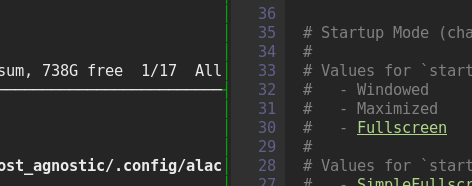
$ fc-match should show the default font, as I understand it. It shows "DejaVu Sans" "Book" on the heavy,
and Nimbus Sans" "Regular" on the light.
But setting “Nimbus Sans” as the font in Alacritty screws up the look, hard.
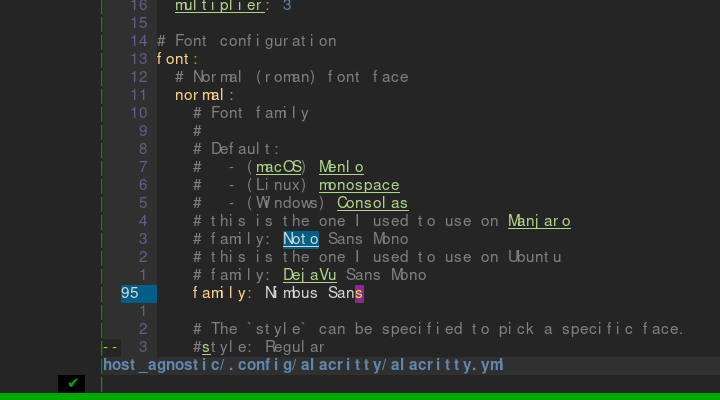
So I’m thinking Alacritty is picking a different font on the light one. Now, to figure out what it is.
It might be worth noting, that Terminator doesn’t have the gaps in vertical separators, even with the same font set as Alacritty.
Oh… right, I wasn’t getting the default monospace fonts with fc-match.
I should’ve called $ fc-match monospace. That gives me DejaVuSansMono.ttf: "DejaVu Sans Mono" "Book"
for the heavy, and Inconsolata-Regular.ttf: "Inconsolata" "Regular" for the light.
Switching to Inconsolata in Alacritty does make the Powerline prompts lose the dashes and gets rid of the gaps in the Tmux separatars. Although the separators have small “bumps” :) Well, I guess I prefer that to gaps.
Ok, now to enforce the same default font on both computers - I won’t just keep that setting in Alacritty. Hmm… I’ll go with “Noto Sans Mono”. The characters look nicer than with Inconsolata. I get the gaps in vertical lines in Tmux, though. Oh well.
Wait, the powerline characters look slightly different on both laptops… Argh! Ok, I will seriously not bother with this. Maybe the future will give me an answer :)
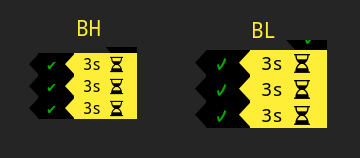
Hmm… I should probably merge machine_setups and configs_and_scripts repos.
I seem to update both of them when I’m working on my setup, and one is calling the other.
Back to the default system monospace font.
For some reason the font configuration is awfully distributed and done in cryptic XML files.
Where’s the man for them? Why isn’t it mentioned in the system files to make customization easy?
I’ve found this bit in man fc-cache:
The fontconfig user's guide, in HTML format: /usr/share/doc/fontconfig/fontconfig-user.html.
But that file doesn’t exist… Oh well, I’m gonna try some bits from the Arch Wiki (love it as a resource), and if that doesn’t work, I’m just gonna set the fonts for Alacritty and be done with this.
Ok, I’m giving up with the fontconfig.
I’ve made ~/.config/fontconfig/fonts.conf look like this:
<?xml version="1.0"?>
<!DOCTYPE fontconfig SYSTEM "fonts.dtd">
<fontconfig>
<!-- Default monospace font -->
<alias binding="strong">
<family>monospace</family>
<prefer>
<family>Noto Sans Mono</family>
</prefer>
</alias>
</fontconfig>
With that, I get the correct font (I think) with fc-match monospace:
NotoSansMono-Regular.ttf: "Noto Sans Mono" "Regular".
And the glyphs look OK. But the right powerline prompts get the missing dashes that aren’t there if I set the
font with Alacritty :D
So I’ll skip fonts.conf and just set the font in Alacritty.
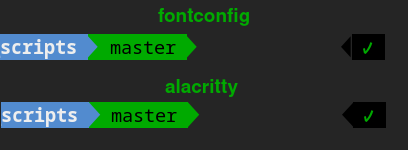
Ok… for the sake of closure and tidiness I’ve merged configs_and_scripts into machine_setups.
2021-09-23
I was trying to wrap up this post and to write a good but short README for machine_setups and it hit me
that it’s hard to explain when to use my upgrade function and when to run the main setup from machine_setups,
since their competence sort of overlaps.
So I made the setup script also update everything. Now upgrade just calls the main setup.
There’s one command to keep everything in sync. Nice, tidy, and simple.
I hope I’ll be done with this post today, but it keeps dragging on into eternity.
Footnotes
